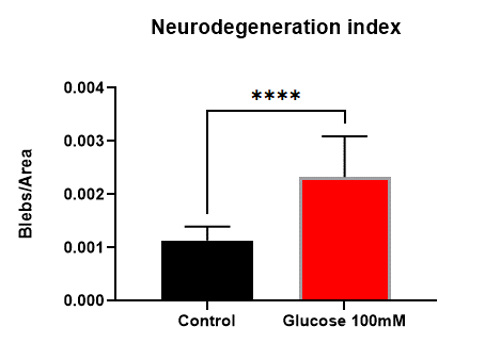Behavior
Conduct extensive pain, sensory, motor, and cognitive behavioral testing.
Neuropathic pain affects nearly 50% of people with diabetes, yet the underlying mechanisms remain incompletely understood. MD Biosciences leverages STZ diabetes models, and high-fat diet diabetic neuropathy models to provide greater insights into the pathophysiology of diabetic neuropathy. By incorporating clinically relevant assessments such as electrophysiology and IENF staining, our preclinical models offer robust tools to evaluate therapeutic interventions and better translate findings to human disease.
The Diabetes Neurodegeneration in vitro screening assay utilizes primary neurons from immature mice or rats. Following the conditioning phase with high concentrations of glucose, cultures are treated with compounds and evaluated for their neurodegeneration index.
The assays are ideal for screening compounds prior to efficacy in in vivo studies.

STZ is used to induce type I diabetes and diabetes-related complications, including diabetic peripheral neuropathy. There are multiple theories on the mechanism that involves peripheral neuropathy following STZ. Some of the mechanisms suggested are related to the hyperglycemic state of the rats suggesting that following the hyperglycemia, nerve endings are damaged either through an inflammatory process or interfering with blood supply. However, vast studies are also suggesting a mechanism of neuronal damage that occurs following STZ but it is unrelated to the hyperglycemic state of the animals.
These studies suggest direct damage to the nerves. For example, reactive oxygen species (ROS) mediate elevation of TRPV1 in neurons and the DRG is exposed to STZ in vitro. Therefore, the STZ model involves direct changes in the nerves that are not related to the inflammatory process.
The high fat diet induced diabetic model is used to study peripheral neuropathy from diabetes types II. Food intake and body weight are measured along with blood glucose levels to determine the onset of type II diabetes.

Cytokine levels in plasma and CSF of male rats show that there are significant differences in these three markers compared to naïve animals. TNF-a and RANTES levels increased while IL-10 levels decreased.
MD Biosciences offers comprehensive in vivo measures and endpoint assessments, delivering robust data packages to support critical research decisions in the evolving landscape of drug development and biomedical research.

Conduct extensive pain, sensory, motor, and cognitive behavioral testing.
Explore inflammatory and pain biomarkers in disease-specific tissues.
Characterize tissue and cellular changes in disease, pain, and neurodegeneration.
Measure motor and sensory evoked potentials to assess disease progression and pain.